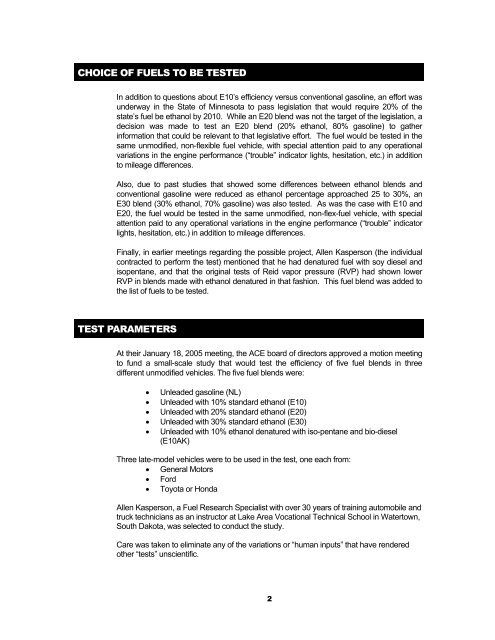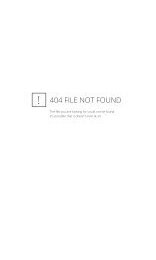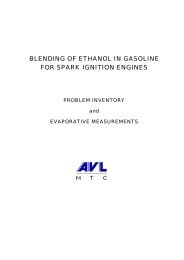FUEL ECONOMY STUDY - American Coalition for Ethanol
FUEL ECONOMY STUDY - American Coalition for Ethanol
FUEL ECONOMY STUDY - American Coalition for Ethanol
You also want an ePaper? Increase the reach of your titles
YUMPU automatically turns print PDFs into web optimized ePapers that Google loves.
CHOICE OF <strong>FUEL</strong>S TO BE TESTED<br />
In addition to questions about E10’s efficiency versus conventional gasoline, an ef<strong>for</strong>t was<br />
underway in the State of Minnesota to pass legislation that would require 20% of the<br />
state’s fuel be ethanol by 2010. While an E20 blend was not the target of the legislation, a<br />
decision was made to test an E20 blend (20% ethanol, 80% gasoline) to gather<br />
in<strong>for</strong>mation that could be relevant to that legislative ef<strong>for</strong>t. The fuel would be tested in the<br />
same unmodified, non-flexible fuel vehicle, with special attention paid to any operational<br />
variations in the engine per<strong>for</strong>mance (“trouble” indicator lights, hesitation, etc.) in addition<br />
to mileage differences.<br />
Also, due to past studies that showed some differences between ethanol blends and<br />
conventional gasoline were reduced as ethanol percentage approached 25 to 30%, an<br />
E30 blend (30% ethanol, 70% gasoline) was also tested. As was the case with E10 and<br />
E20, the fuel would be tested in the same unmodified, non-flex-fuel vehicle, with special<br />
attention paid to any operational variations in the engine per<strong>for</strong>mance (“trouble” indicator<br />
lights, hesitation, etc.) in addition to mileage differences.<br />
Finally, in earlier meetings regarding the possible project, Allen Kasperson (the individual<br />
contracted to per<strong>for</strong>m the test) mentioned that he had denatured fuel with soy diesel and<br />
isopentane, and that the original tests of Reid vapor pressure (RVP) had shown lower<br />
RVP in blends made with ethanol denatured in that fashion. This fuel blend was added to<br />
the list of fuels to be tested.<br />
TEST PARAMETERS<br />
At their January 18, 2005 meeting, the ACE board of directors approved a motion meeting<br />
to fund a small-scale study that would test the efficiency of five fuel blends in three<br />
different unmodified vehicles. The five fuel blends were:<br />
• Unleaded gasoline (NL)<br />
• Unleaded with 10% standard ethanol (E10)<br />
• Unleaded with 20% standard ethanol (E20)<br />
• Unleaded with 30% standard ethanol (E30)<br />
• Unleaded with 10% ethanol denatured with iso-pentane and bio-diesel<br />
(E10AK)<br />
Three late-model vehicles were to be used in the test, one each from:<br />
• General Motors<br />
• Ford<br />
• Toyota or Honda<br />
Allen Kasperson, a Fuel Research Specialist with over 30 years of training automobile and<br />
truck technicians as an instructor at Lake Area Vocational Technical School in Watertown,<br />
South Dakota, was selected to conduct the study.<br />
Care was taken to eliminate any of the variations or “human inputs” that have rendered<br />
other “tests” unscientific.<br />
2




